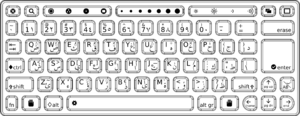Arabic language
- Wikipedia
- Arabic (اللغة العربية al-luġatu l-ʿarabiyyah or just عربي ʿarabī) is the largest living member of the Semitic language family in terms of speakers. Classified as Central Semitic, it is closely related to Hebrew and Aramaic. Modern Arabic is classified as a macrolanguage with 27 sub-languages in ISO 639-3. These varieties are spoken throughout the Arab world, and Standard Arabic is widely studied and known throughout the Islamic world.
Modern Standard Arabic derives from Classical Arabic, the only surviving member of the Old North Arabian dialect group, attested epigraphically since the 6th century, which has been a literary language and the liturgical language of Islam since the 7th century.
Arabic has lent many words to other languages of the Islamic world, akin to the role Latin has in Western European languages. During the Middle Ages Arabic was also a major vehicle of culture, especially in science, mathematics and philosophy, with the result that many European languages have also borrowed numerous words from it.
Alphabets
Countries / Regions
- Algeria
- Bahrain
- Egypt
- Israel (as a minority)
- Iran (as a minority)
- Iraq
- Jordan
- Kuwait
- Lebanon
- Libya
- Mauritania
- Morocco
- Oman
- ARMM Philippines (Autonomous Region for Muslim Mindanao & as a minority)
- Qatar
- Saudi Arabia
- Sudan
- Syria
- Tunisia
- United Arab Emirates
- Palestinian territories
- Western Sahara (SADR)
- Yemen
Note: it is also the liturgical language of Islam.
Arabic is fully supported in many Category:Linux distributions. There is much less support for other languages using the Arabic alphabet, such as Farsi in Iran; Azeri in Azerbaijan; Pashto, Dari and others in Afghanistan; and Urdu and others in Pakistan. The letters for all of these languages and more are included in Unicode.
Debian Arabic keyboard
1 2 3 4 5 6 7 8 9 0 [ ] د ج ح خ ه ع غ ف ق ث ص ض ط ك م ن ت ا ل ب ي س ش ظ ز و ة ى ﻻ ر ؤ ء ئ
Requires Arabic font and correct right-to-left rendering to display properly.
Unicode
The Unicode block for Arabic is U+0600-U+06FF. There are two other blocks for Arabic Presentation Forms. They are included in Unicode because they were present in earlier standards from other sources. Almost all of these forms can be generated by software that correctly handles Arabic ligatures. The forms that cannot be generated in the desired manner in word processing software should normally appear as graphics anyway.
Arabic Support Task List
Linux Arabic support is in a good shape overall today. The following is a list of what is left to do, or what needs to be done beyond existing support to allow OLPC to seamlessly useable by an Arabic-speaking child. If you know of existing solutions to address any of this list, please add it to this page so that we end up with as comprehensive a list as possible.
On the other hand, the best thing you can do to help if you have the needed skills, is to take ownership of any of the following challenges or point out existing solutions:
- Bugs in linux Arabic support and Open Source libraries
- Pango rendering for Extended Arabic
- Arabic text normalization (Search engines, spell checking)
- Free fonts (below)
- Support applications
- Open source OCR solution
- Spell checkers
- Arabic content
- Wikipedia (see link below)
- Localized or natively Arabic educational content
- More Arabic literature online
Fonts
The following Free TrueType/OpenType font packages include Arabic alphabet for Arabic and other languages.
- Arabeyes 39 Arabic fonts
- Dejavu
- FarsiWeb, for Farsi
- KACST, from King Abdulaziz City for Science and Technology
- MPH 2B Damase
- Nafees, for Urdu
- Paktype Naqsh and Tehreer, for Urdu
We need some knowledgeable people to try all of these out in the languages of interest, including at least modern Arabic, Qur'anic Arabic, Farsi, Dari, Pashto, Urdu, Sindhi, Azeri, and Hausa, and tell us how we are doing and what more we need.
